FORD E SERIES 2014 4.G Owner's Guide
Manufacturer: FORD, Model Year: 2014, Model line: E SERIES, Model: FORD E SERIES 2014 4.GPages: 438, PDF Size: 5.12 MB
Page 31 of 438
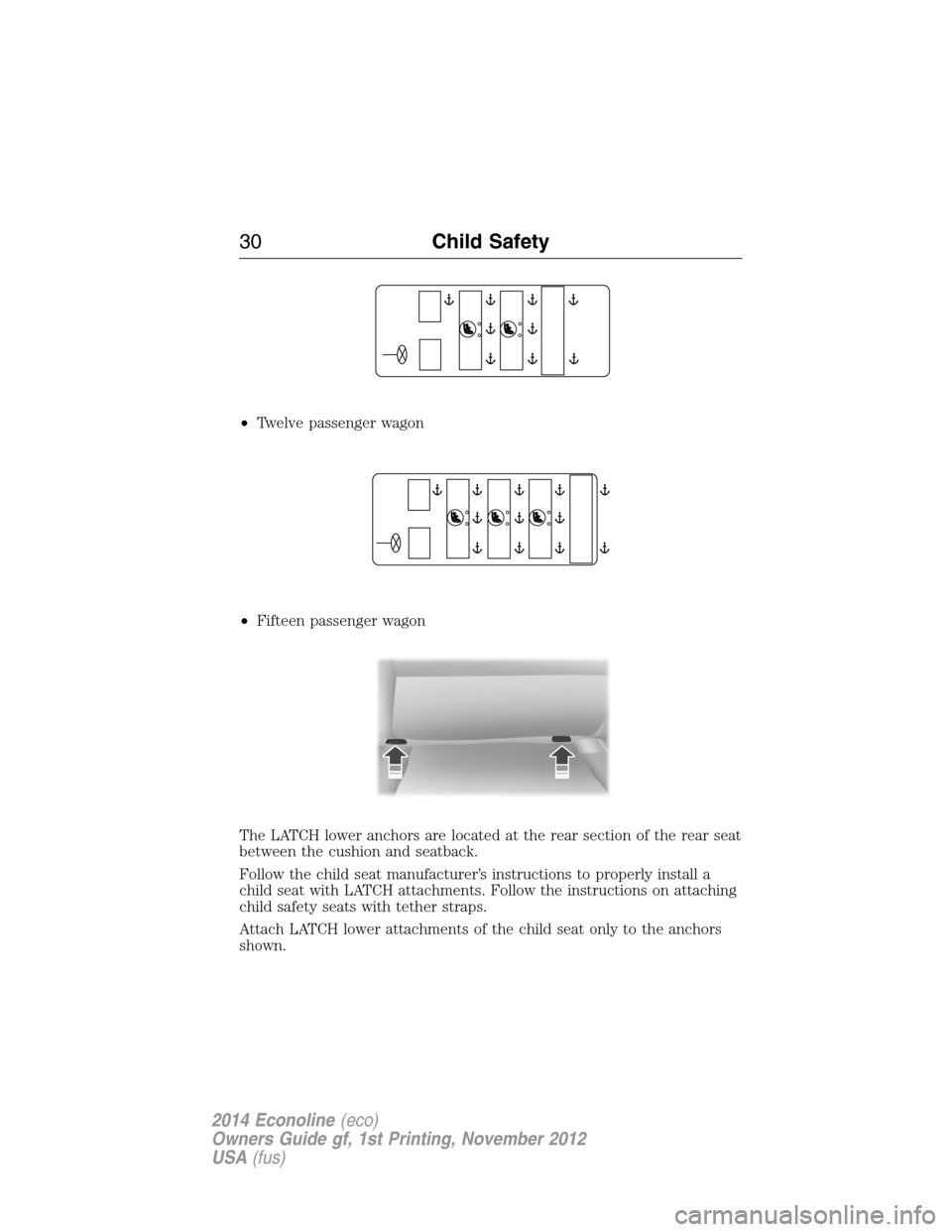
•Twelve passenger wagon
•Fifteen passenger wagon
The LATCH lower anchors are located at the rear section of the rear seat
between the cushion and seatback.
Follow the child seat manufacturer’s instructions to properly install a
child seat with LATCH attachments. Follow the instructions on attaching
child safety seats with tether straps.
Attach LATCH lower attachments of the child seat only to the anchors
shown.
30Child Safety
2014 Econoline(eco)
Owners Guide gf, 1st Printing, November 2012
USA(fus)
Page 32 of 438

Each time you use the safety seat, check that the seat is properly
attached to the lower anchors and tether anchor, if applicable. Tug the
child seat from side to side and forward and back where it is secured to
the vehicle. The seat should move less than one inch when you do this
for a proper installation. If the safety seat is not anchored properly, the
risk of a child being injured in a crash greatly increases.
Combining Safety Belt and LATCH Lower Anchors for Attaching
Child Safety Seats
When used in combination, either the safety belt or the LATCH lower
anchors may be attached first, provided a proper installation is achieved.
Attach the tether strap afterward, if included with the child seat.
Using Tether Straps
Many forward-facing child safety seats include a tether strap
which extends from the back of the child safety seat and hooks
to an anchoring point called the top tether anchor. Tether
straps are available as an accessory for many older safety seats.
Contact the manufacturer of your child seat for information about
ordering a tether strap, or to obtain a longer tether strap if the tether
strap on your safety seat does not reach the appropriate top tether
anchor in the vehicle.
Attach the tether strap only to the appropriate tether anchor as shown.
The tether strap may not work properly if attached somewhere other
than the correct tether anchor.
Note:If you install a child seat with rigid LATCH attachments, and have
attached the top tether strap to the proper top tether anchor, do not
tighten the tether strap enough to lift the child seat off the vehicle seat
cushion when the child is seated in it. Keep the tether strap just snug
without lifting the front of the child seat. Keeping the child seat just
touching the vehicle seat gives the best protection in a severe crash.
Child Safety31
2014 Econoline(eco)
Owners Guide gf, 1st Printing, November 2012
USA(fus)
Page 33 of 438
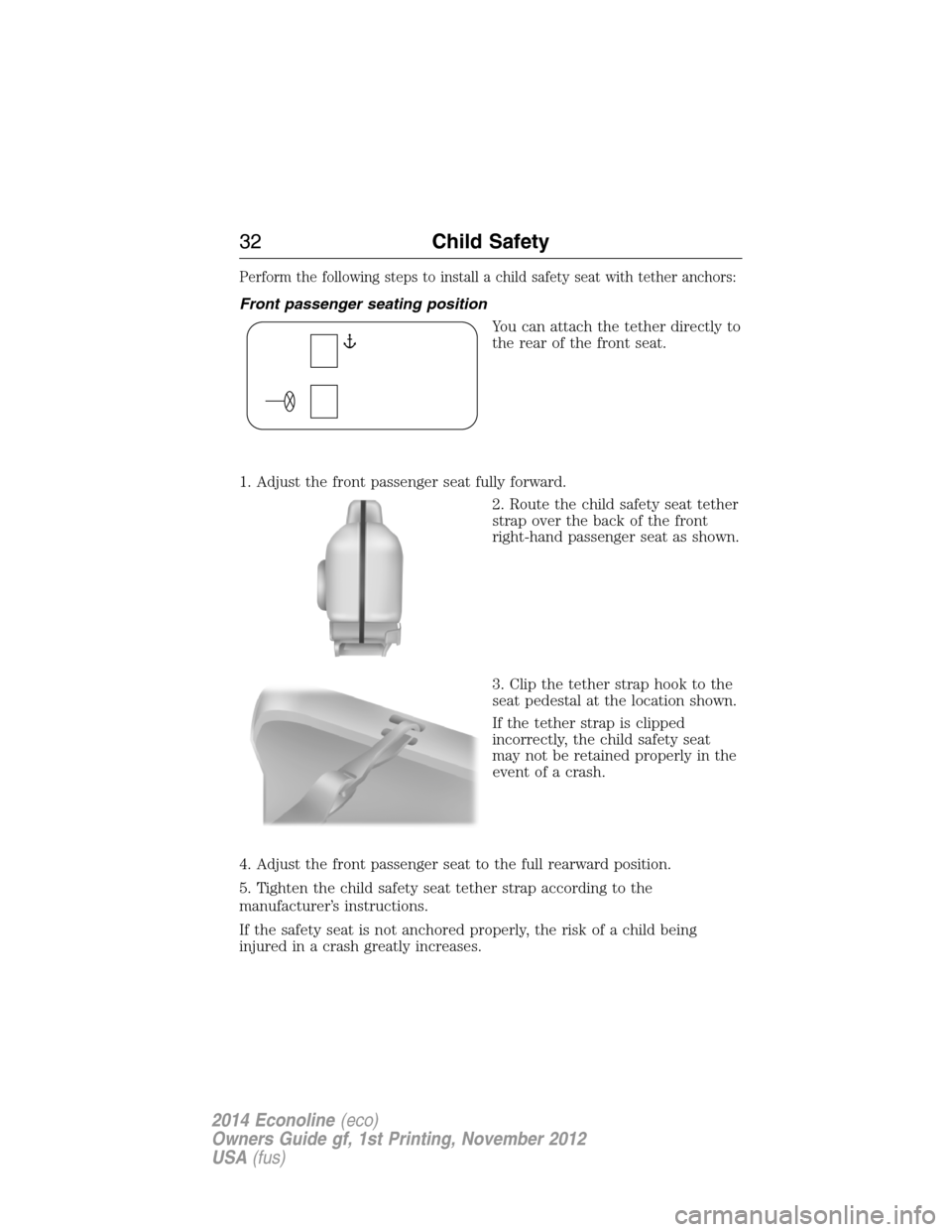
Perform the following steps to install a child safety seat with tether anchors:
Front passenger seating position
You can attach the tether directly to
the rear of the front seat.
1. Adjust the front passenger seat fully forward.
2. Route the child safety seat tether
strap over the back of the front
right-hand passenger seat as shown.
3. Clip the tether strap hook to the
seat pedestal at the location shown.
If the tether strap is clipped
incorrectly, the child safety seat
may not be retained properly in the
event of a crash.
4. Adjust the front passenger seat to the full rearward position.
5. Tighten the child safety seat tether strap according to the
manufacturer’s instructions.
If the safety seat is not anchored properly, the risk of a child being
injured in a crash greatly increases.
32Child Safety
2014 Econoline(eco)
Owners Guide gf, 1st Printing, November 2012
USA(fus)
Page 34 of 438

Second Row Bucket Seats
You can attach the tether strap
directly to the tether bracket under
the back edge of the seat cushion.
1. Route the child safety tether strap over the back of the left hand or
right hand second row bucket seat.
2. Clip the tether strap hook to the
seat pedestal at the location shown.
If the tether strap is clipped
incorrectly, the child safety seat
may not be retained properly in the
event of a crash.
3. Tighten the child safety seat tether strap according to the
manufacturer’s instructions.
If the safety seat is not anchored properly, the risk of a child being
injured in a crash greatly increases.
Child Safety33
2014 Econoline(eco)
Owners Guide gf, 1st Printing, November 2012
USA(fus)
Page 35 of 438
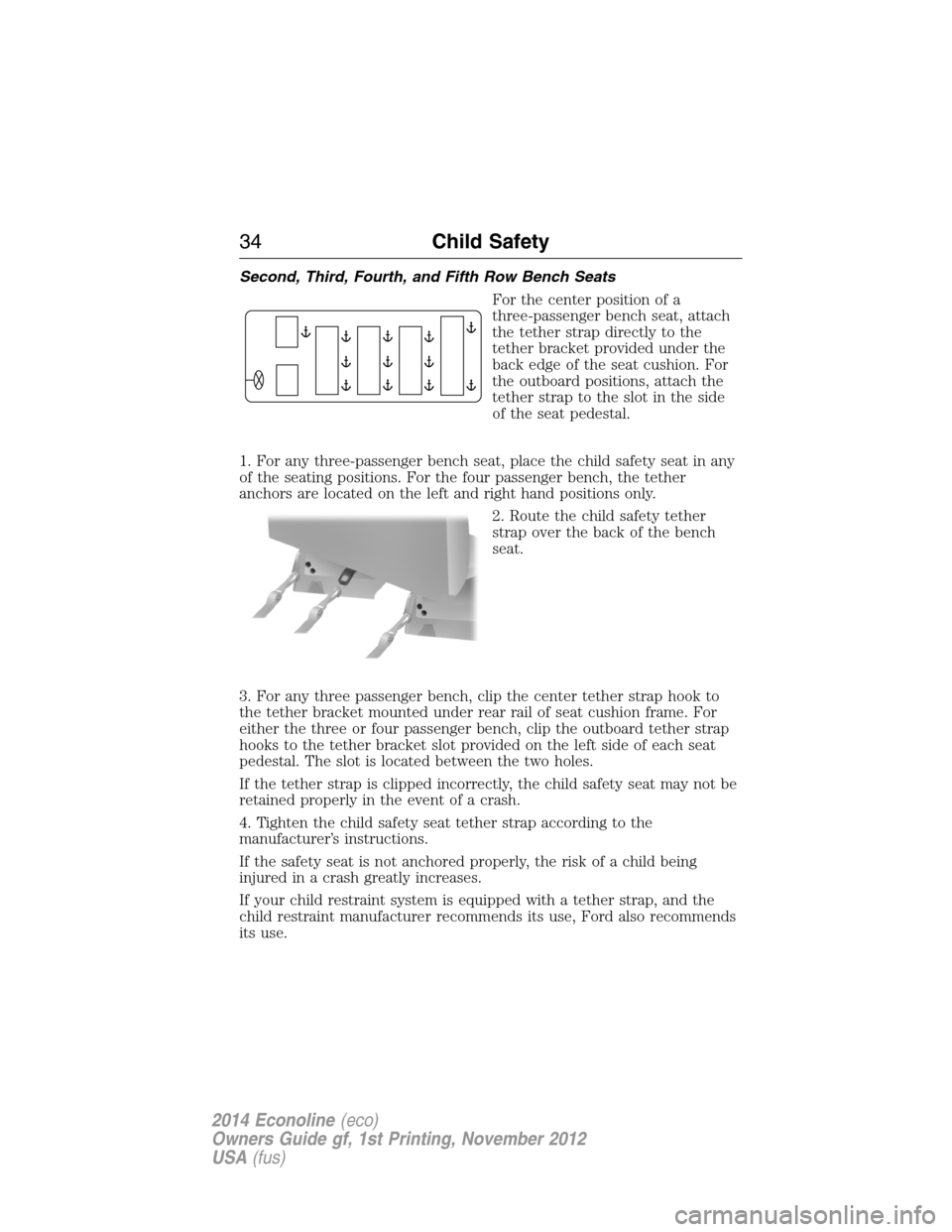
Second, Third, Fourth, and Fifth Row Bench Seats
For the center position of a
three-passenger bench seat, attach
the tether strap directly to the
tether bracket provided under the
back edge of the seat cushion. For
the outboard positions, attach the
tether strap to the slot in the side
of the seat pedestal.
1. For any three-passenger bench seat, place the child safety seat in any
of the seating positions. For the four passenger bench, the tether
anchors are located on the left and right hand positions only.
2. Route the child safety tether
strap over the back of the bench
seat.
3. For any three passenger bench, clip the center tether strap hook to
the tether bracket mounted under rear rail of seat cushion frame. For
either the three or four passenger bench, clip the outboard tether strap
hooks to the tether bracket slot provided on the left side of each seat
pedestal. The slot is located between the two holes.
If the tether strap is clipped incorrectly, the child safety seat may not be
retained properly in the event of a crash.
4. Tighten the child safety seat tether strap according to the
manufacturer’s instructions.
If the safety seat is not anchored properly, the risk of a child being
injured in a crash greatly increases.
If your child restraint system is equipped with a tether strap, and the
child restraint manufacturer recommends its use, Ford also recommends
its use.
34Child Safety
2014 Econoline(eco)
Owners Guide gf, 1st Printing, November 2012
USA(fus)
Page 36 of 438
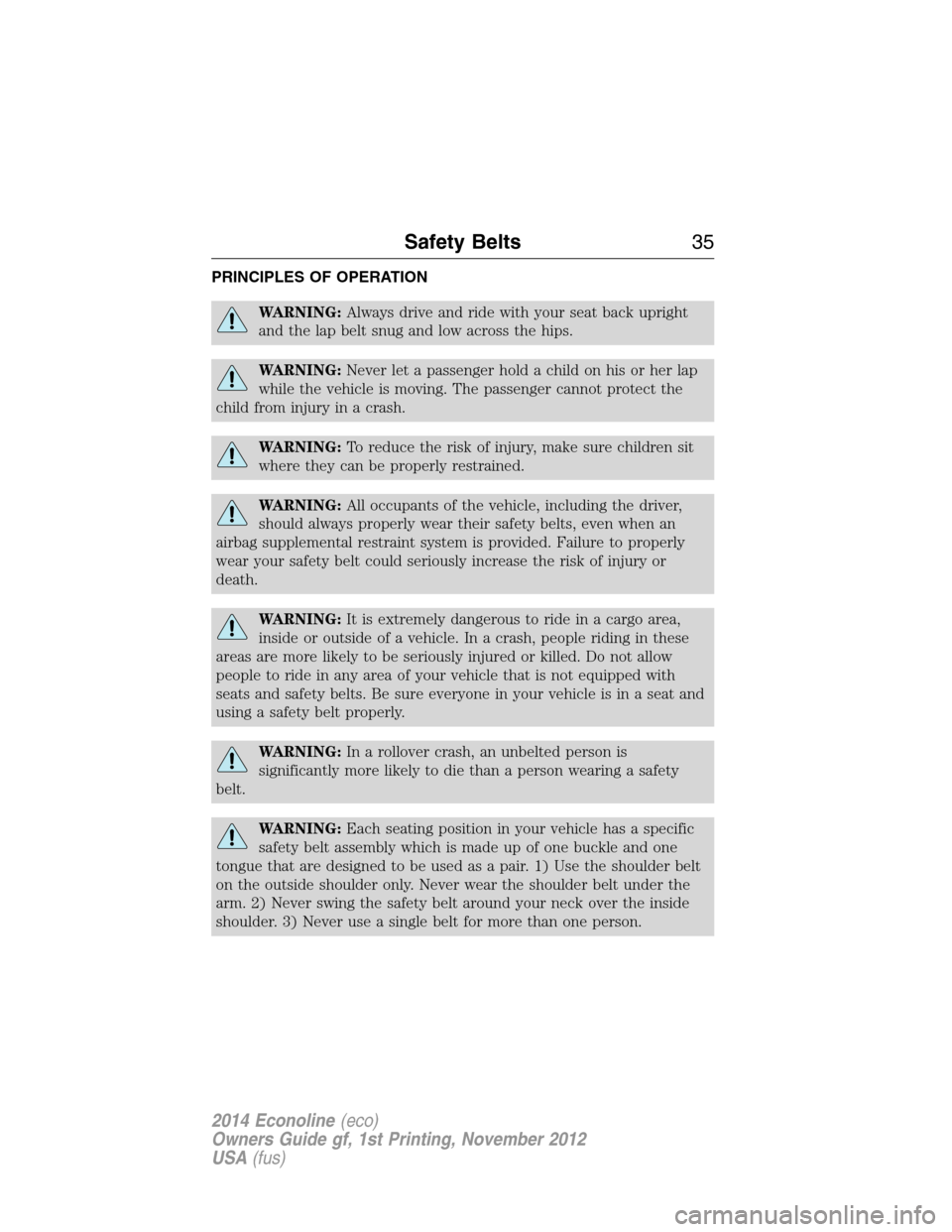
PRINCIPLES OF OPERATION
WARNING:Always drive and ride with your seat back upright
and the lap belt snug and low across the hips.
WARNING:Never let a passenger hold a child on his or her lap
while the vehicle is moving. The passenger cannot protect the
child from injury in a crash.
WARNING:To reduce the risk of injury, make sure children sit
where they can be properly restrained.
WARNING:All occupants of the vehicle, including the driver,
should always properly wear their safety belts, even when an
airbag supplemental restraint system is provided. Failure to properly
wear your safety belt could seriously increase the risk of injury or
death.
WARNING:It is extremely dangerous to ride in a cargo area,
inside or outside of a vehicle. In a crash, people riding in these
areas are more likely to be seriously injured or killed. Do not allow
people to ride in any area of your vehicle that is not equipped with
seats and safety belts. Be sure everyone in your vehicle is in a seat and
using a safety belt properly.
WARNING:In a rollover crash, an unbelted person is
significantly more likely to die than a person wearing a safety
belt.
WARNING:Each seating position in your vehicle has a specific
safety belt assembly which is made up of one buckle and one
tongue that are designed to be used as a pair. 1) Use the shoulder belt
on the outside shoulder only. Never wear the shoulder belt under the
arm. 2) Never swing the safety belt around your neck over the inside
shoulder. 3) Never use a single belt for more than one person.
Safety Belts35
2014 Econoline(eco)
Owners Guide gf, 1st Printing, November 2012
USA(fus)
Page 37 of 438
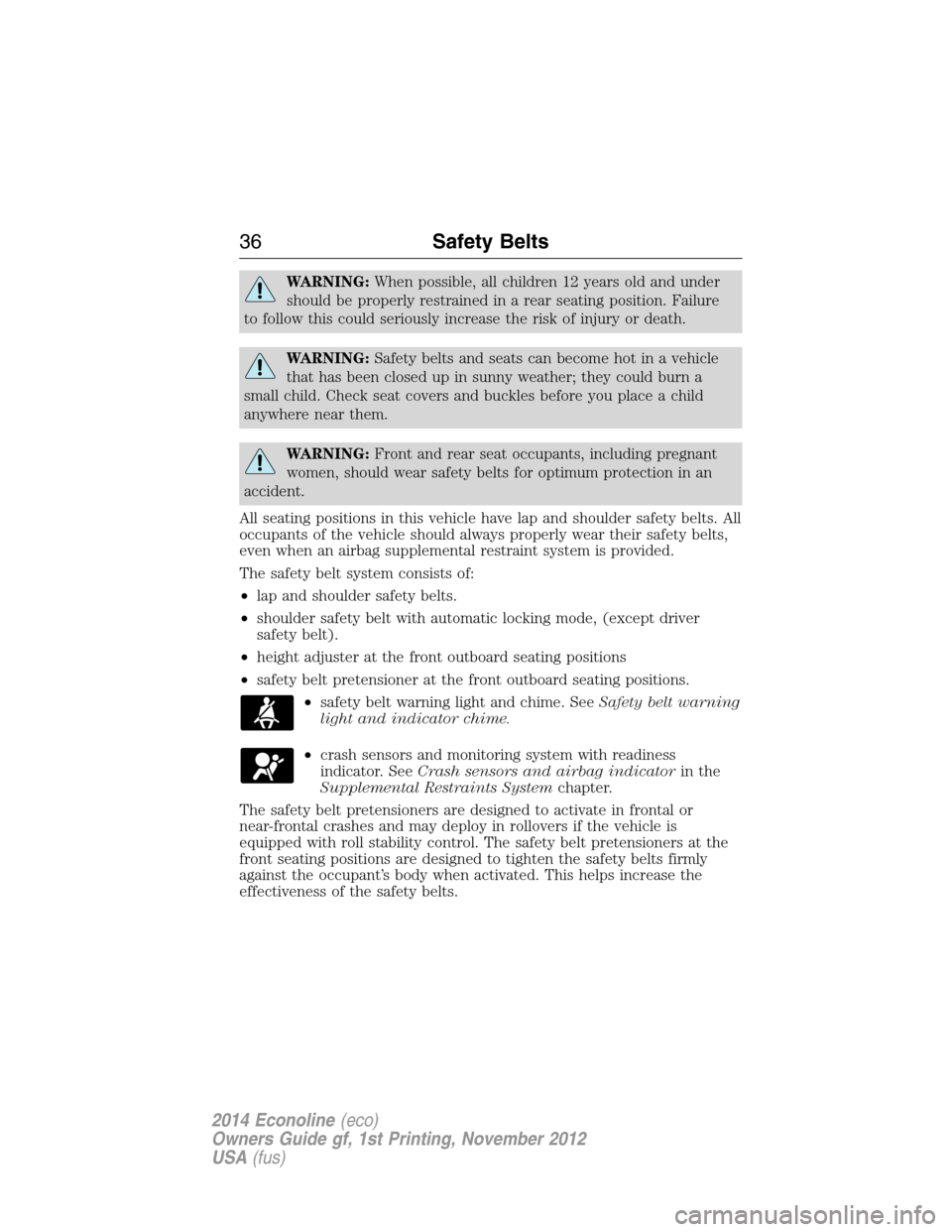
WARNING:When possible, all children 12 years old and under
should be properly restrained in a rear seating position. Failure
to follow this could seriously increase the risk of injury or death.
WARNING:Safety belts and seats can become hot in a vehicle
that has been closed up in sunny weather; they could burn a
small child. Check seat covers and buckles before you place a child
anywhere near them.
WARNING:Front and rear seat occupants, including pregnant
women, should wear safety belts for optimum protection in an
accident.
All seating positions in this vehicle have lap and shoulder safety belts. All
occupants of the vehicle should always properly wear their safety belts,
even when an airbag supplemental restraint system is provided.
The safety belt system consists of:
•lap and shoulder safety belts.
•shoulder safety belt with automatic locking mode, (except driver
safety belt).
•height adjuster at the front outboard seating positions
•safety belt pretensioner at the front outboard seating positions.
•safety belt warning light and chime. SeeSafety belt warning
light and indicator chime.
•crash sensors and monitoring system with readiness
indicator. SeeCrash sensors and airbag indicatorin the
Supplemental Restraints Systemchapter.
The safety belt pretensioners are designed to activate in frontal or
near-frontal crashes and may deploy in rollovers if the vehicle is
equipped with roll stability control. The safety belt pretensioners at the
front seating positions are designed to tighten the safety belts firmly
against the occupant’s body when activated. This helps increase the
effectiveness of the safety belts.
36Safety Belts
2014 Econoline(eco)
Owners Guide gf, 1st Printing, November 2012
USA(fus)
Page 38 of 438
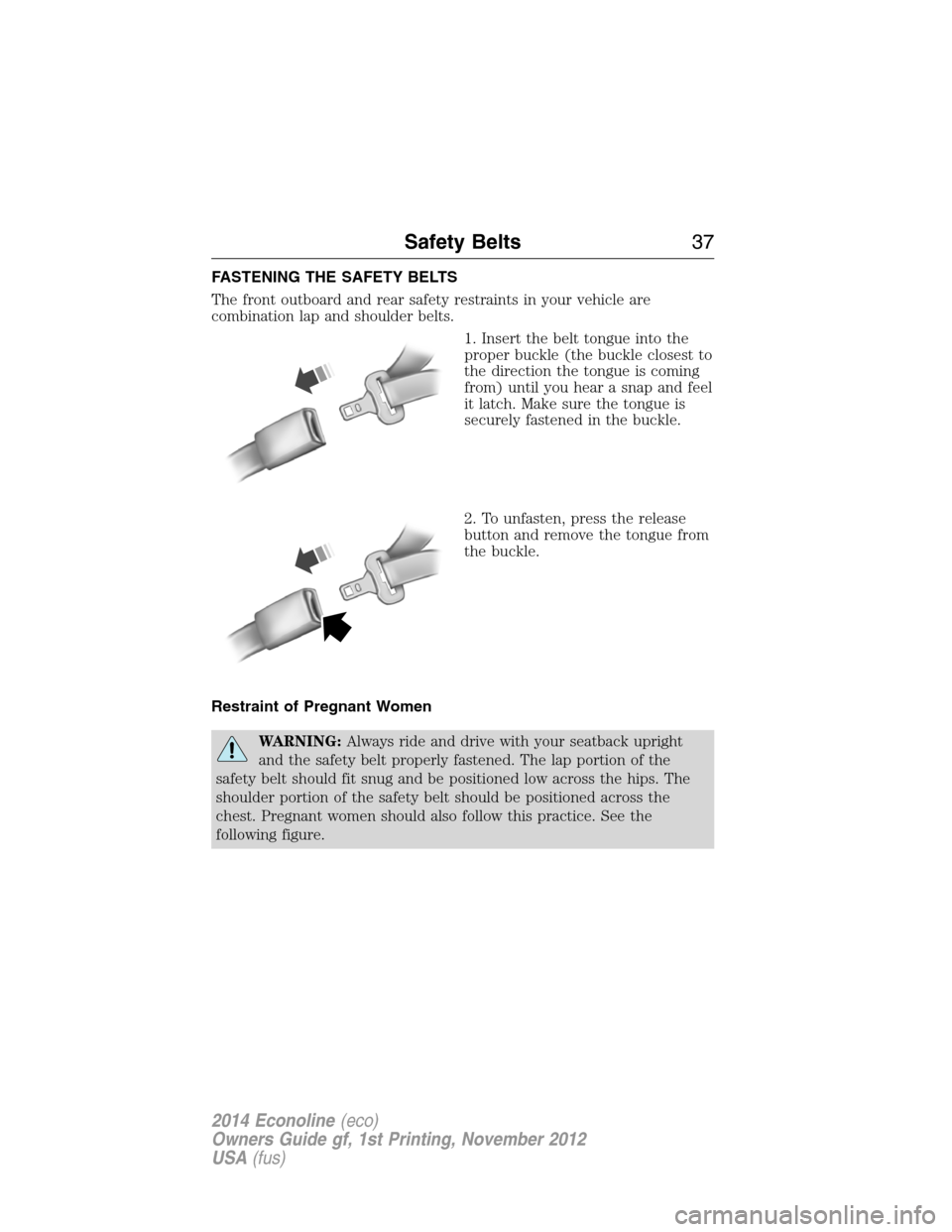
FASTENING THE SAFETY BELTS
The front outboard and rear safety restraints in your vehicle are
combination lap and shoulder belts.
1. Insert the belt tongue into the
proper buckle (the buckle closest to
the direction the tongue is coming
from) until you hear a snap and feel
it latch. Make sure the tongue is
securely fastened in the buckle.
2. To unfasten, press the release
button and remove the tongue from
the buckle.
Restraint of Pregnant Women
WARNING:Always ride and drive with your seatback upright
and the safety belt properly fastened. The lap portion of the
safety belt should fit snug and be positioned low across the hips. The
shoulder portion of the safety belt should be positioned across the
chest. Pregnant women should also follow this practice. See the
following figure.
Safety Belts37
2014 Econoline(eco)
Owners Guide gf, 1st Printing, November 2012
USA(fus)
Page 39 of 438
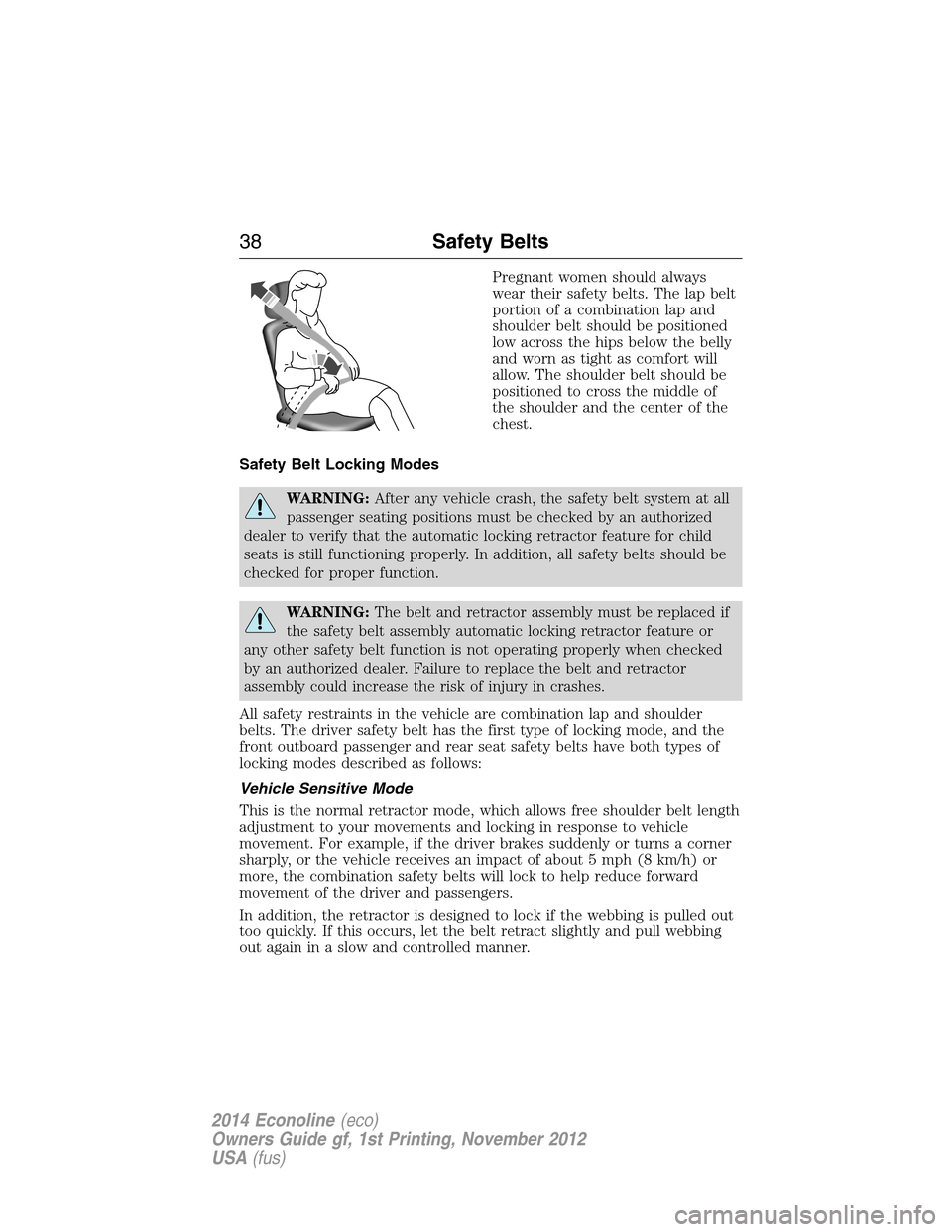
Pregnant women should always
wear their safety belts. The lap belt
portion of a combination lap and
shoulder belt should be positioned
low across the hips below the belly
and worn as tight as comfort will
allow. The shoulder belt should be
positioned to cross the middle of
the shoulder and the center of the
chest.
Safety Belt Locking Modes
WARNING:After any vehicle crash, the safety belt system at all
passenger seating positions must be checked by an authorized
dealer to verify that the automatic locking retractor feature for child
seats is still functioning properly. In addition, all safety belts should be
checked for proper function.
WARNING:The belt and retractor assembly must be replaced if
the safety belt assembly automatic locking retractor feature or
any other safety belt function is not operating properly when checked
by an authorized dealer. Failure to replace the belt and retractor
assembly could increase the risk of injury in crashes.
All safety restraints in the vehicle are combination lap and shoulder
belts. The driver safety belt has the first type of locking mode, and the
front outboard passenger and rear seat safety belts have both types of
locking modes described as follows:
Vehicle Sensitive Mode
This is the normal retractor mode, which allows free shoulder belt length
adjustment to your movements and locking in response to vehicle
movement. For example, if the driver brakes suddenly or turns a corner
sharply, or the vehicle receives an impact of about 5 mph (8 km/h) or
more, the combination safety belts will lock to help reduce forward
movement of the driver and passengers.
In addition, the retractor is designed to lock if the webbing is pulled out
too quickly. If this occurs, let the belt retract slightly and pull webbing
out again in a slow and controlled manner.
38Safety Belts
2014 Econoline(eco)
Owners Guide gf, 1st Printing, November 2012
USA(fus)
Page 40 of 438
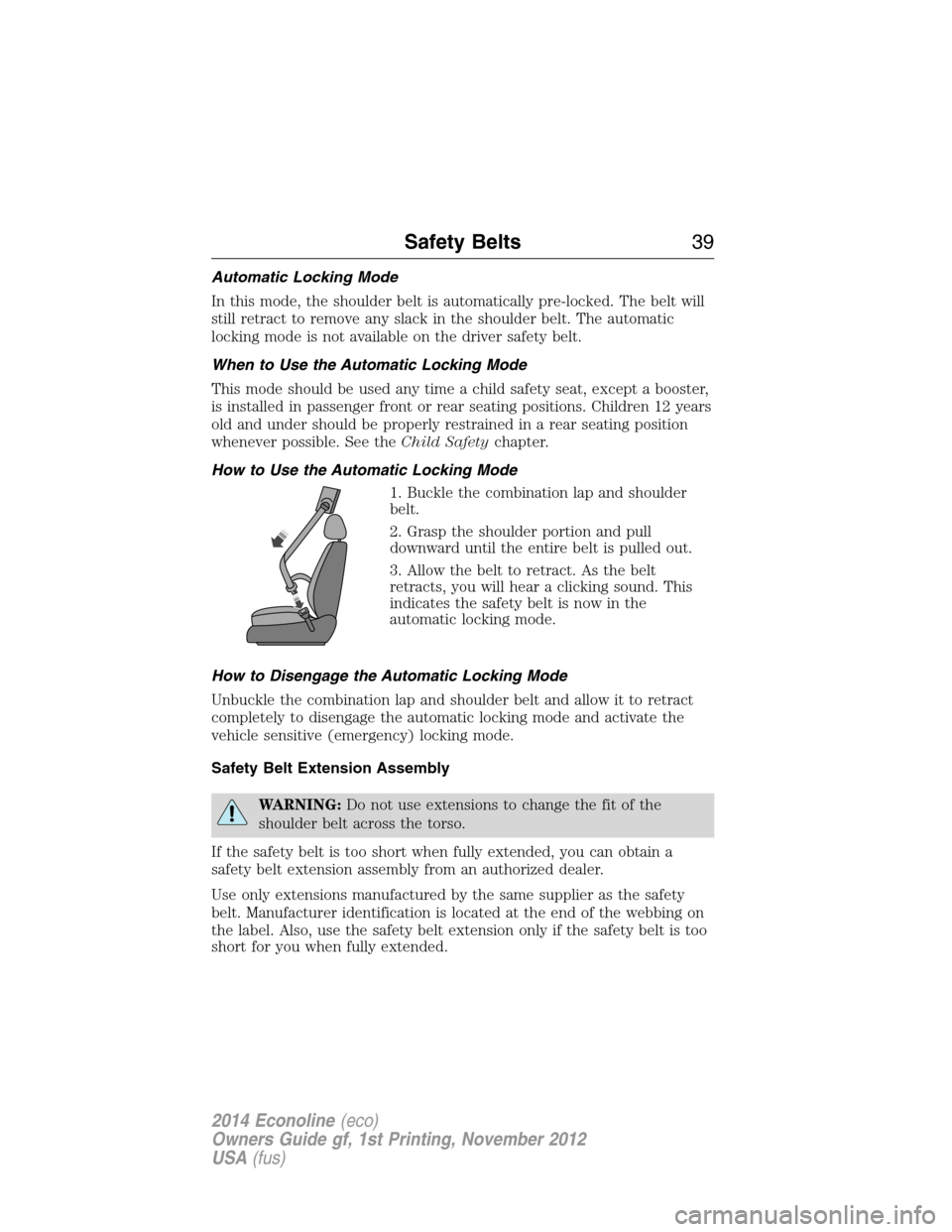
Automatic Locking Mode
In this mode, the shoulder belt is automatically pre-locked. The belt will
still retract to remove any slack in the shoulder belt. The automatic
locking mode is not available on the driver safety belt.
When to Use the Automatic Locking Mode
This mode should be used any time a child safety seat, except a booster,
is installed in passenger front or rear seating positions. Children 12 years
old and under should be properly restrained in a rear seating position
whenever possible. See theChild Safetychapter.
How to Use the Automatic Locking Mode
1. Buckle the combination lap and shoulder
belt.
2. Grasp the shoulder portion and pull
downward until the entire belt is pulled out.
3. Allow the belt to retract. As the belt
retracts, you will hear a clicking sound. This
indicates the safety belt is now in the
automatic locking mode.
How to Disengage the Automatic Locking Mode
Unbuckle the combination lap and shoulder belt and allow it to retract
completely to disengage the automatic locking mode and activate the
vehicle sensitive (emergency) locking mode.
Safety Belt Extension Assembly
WARNING:Do not use extensions to change the fit of the
shoulder belt across the torso.
If the safety belt is too short when fully extended, you can obtain a
safety belt extension assembly from an authorized dealer.
Use only extensions manufactured by the same supplier as the safety
belt. Manufacturer identification is located at the end of the webbing on
the label. Also, use the safety belt extension only if the safety belt is too
short for you when fully extended.
Safety Belts39
2014 Econoline(eco)
Owners Guide gf, 1st Printing, November 2012
USA(fus)